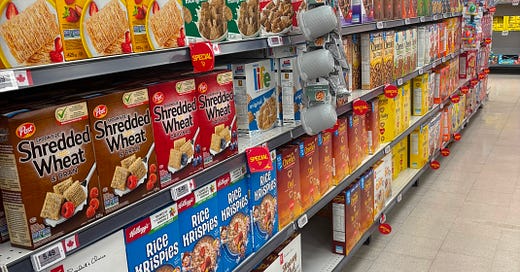Your complete guide to the cereal aisle
Three tips to select the best cereal. Plus 14 cereal brands that check all the boxes.
Hello readers! This week, we’re talking cereal. While the cereal category is broad, it’s relatively stable compared to others, and is largely made up of brands that have been around for decades. Still, the sheer variety can be overwhelming. To help you navigate this aisle with confidence, I’ve put together a guide for choosing the right cereal. And because I know your time is valuable, I’ve also included 14 cereal brands that check all the boxes.
You can check out my previous grocery guides below:
If you haven’t already done so, hit the Subscribe button below so you don’t miss any future editions of The Grocery Edit!
Note: if part of this post gets cut off in your inbox (due to length), click the ‘READ IN APP’ button at the top of this page for the full version.
If you’re reading this on email, you can access previous editions of The Grocery Edit by downloading the free Substack app below.
Cereal has been a staple in North American breakfasts for decades, and it's easy to see why. It's quick, convenient, and, most importantly, delicious! However, finding a nutritious cereal can be a challenge. For starters, the cereal aisle is vast, making it overwhelming to navigate through countless options and compare nutrition labels. On top of that, many cereals are heavily marketed with claims that appeal to consumers’ desire for nutritious choices, but these claims are often baseless and can be misleading.
After reviewing nearly every cereal on the market, I’ve put together this guide to help you navigate the choices. The recommendations below are designed to support a healthy dietary pattern1, and are relative to the options you’ll find on grocery store shelves.
But first, a quick note about cereal. Nearly all cold breakfast cereals are ultra-processed. As a result, even higher-fibre, whole-grain cereals tend to have a higher glycemic index than other whole grain sources. This means they may digest more quickly and might not be as satiating as alternative breakfast options, especially if they’re not paired with a source of protein and healthy fats. That said, this doesn’t mean they can’t still be a nutritious and suitable option. If you find that cereal doesn’t keep you full, another breakfast option may be a better fit. On the other hand, if a bowl of high-fibre cereal keeps you feeling satisfied and is something you enjoy, it can definitely be a great choice for YOU.
How to choose a cereal
Traditional cold breakfast cereal is primarily made from grains, making carbohydrates the main source of nutrients. While some cereals may contain small amounts of fat and protein, these are typically minimal and come from the grains themselves. Because of this, we can simplify our label reading by focusing mainly on the carbohydrate section (highlighted in the image below). This way, instead of getting distracted and ultimately overwhelmed by the small differences in fat and protein content, we'll concentrate on what matters most in this category: carbohydrates, specifically fibre and sugar content.
Innovation in the cereal category
Recently there has been an influx of innovative cereals on the market made with protein, fat, or fibre sources as the primary ingredient. These cereals are often marketed as high-protein, keto, or grain-free to align with current industry trends. This segment of the cereal category is relatively small and tends to be more volatile than the rest. Many of these cereals are low in fibre or high in sugar, with the exception of the brands included in my list below. For this reason, I haven’t included shopping tips for these options in this guide, but I will highlight exceptions to my tips where relevant.
A note about serving sizes
As I mentioned in my previous deep dive on serving sizes, cereal serving sizes have been standardized over the years to make comparing products easier. In Canada, all cereals have a serving size of 1-cup. In the U.S., serving sizes are based on weight in grams. While many American cereal labels have a 1-cup serving size based on the typical weight range of grain-based cereals, there are some exceptions. For example, nuts are relatively heavy ingredients, so a cereal containing almonds will likely have a smaller cup-based serving size (e.g., 3/4 cup) compared to a cereal made from only grains, even though both may have a similar gram-based serving size (e.g., 55 g). While this can complicate label reading, remember that serving sizes are simply a measure to base the nutrition facts on and not a suggested or recommended intake.
Tip #1: Choose a high-fibre cereal.
🔓 This is where we get into the practical stuff: how to read labels, spot better products, and shop with more confidence. Paid subscribers get access to the full post and the tools to make better food choices without second-guessing.
👉 Upgrade to paid and get instant access.
Keep reading with a 7-day free trial
Subscribe to The Grocery Edit to keep reading this post and get 7 days of free access to the full post archives.





